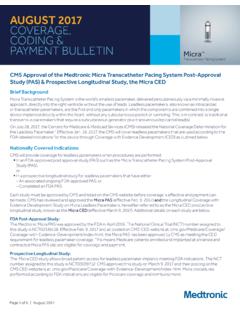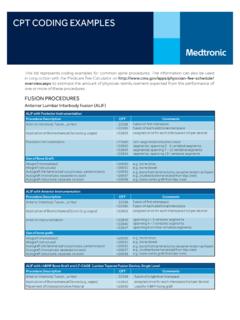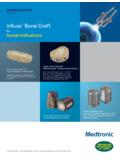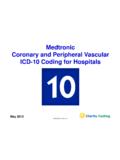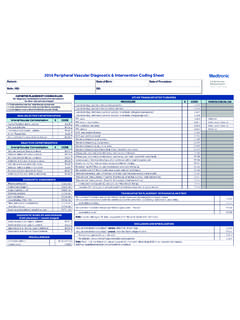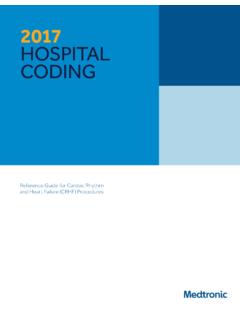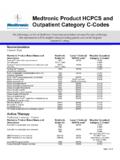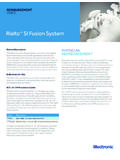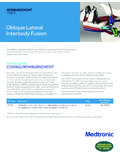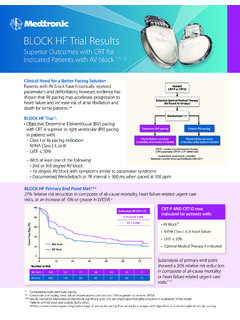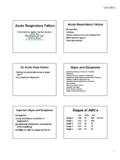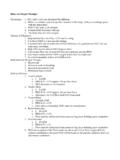Transcription of SPECIFICATIONS - Medtronic
1 Product specificationsMR-conditionalMRInitial ImplantExisting ImplantPhysical CharacteristicsTy p eSingle coil, tripolarFixationHelix, active fixationMR-conditional Lengths55, 62 cmNot approved for MRI49, 72, 97 cmConnectorQuadripolar (three active circuits)Four-pole inline configuration (DF4-LLHO)MaterialsConductorsMP35N coilMP35N composite cablesInsulationSilicone, PTFE, ETFEO verlayIsoglide PolyurethaneTip electrode (pace, sense)Platinized platinum alloyRing electrode (pace, sense)Platinized platinum alloyRV coilPlatinum-clad TantalumDF4 pin and ringMP35 NSteroid typeDexamethasone acetate and dexamethasone sodium phosphateDiametersLead Fr ( mm) Fr ( mm) Fr ( mm)SPECIFICATIONSS print Quattro Secure S MRI SureScan 6935 MSprint Quattro Secure S 6935M Dexamethasone acetate and dexamethasone sodium phosphate steroid-eluting Tripolar Screw-in Ventricular lead with RV defibrillation coil electrodeLead introducer (recommended sizes)Without guide Fr ( mm)With guide Fr ( mm)
2 ElectrodesDefibrillation, RV coilLength57 mmSurface area614 m m2 Ring, Surface mm2 Helix, Surface mm2 Spacing8 mm tip-ring 12 mm tip-distal RV coilBrief StatementSprint Quattro Family of LeadsIndicationsMedtronic Sprint Quattro leads are intended for pacing and sensing and/or defibrillation. Defibrillation leads have application for patients for whom implantable cardioverter defibrillation is Sprint Quattro MRI SureScan Leads (which include specified lengths of Models 6935, 6935M, 6947 and 6947M) are part of a Medtronic SureScan ICD or CRT-D system. Consult individual lead model technical manuals for more detail.
3 A complete SureScan def ibrillation or CRT-D system is required for use in the MR environment and includes a Medtronic SureScan device connected to Medtronic SureScan Leads. ContraindicationsThe Sprint Quattro leads are contraindicated: For the sole use of detection and treatment of atrial arrhythmias In patients with tricuspid valvular disease and/or patients with mechanical tricuspid heart valves For patients with transient ventricular tachyarrythmias due to reversible causes (drug intoxication, electrolyte imbalance, sepsis, hypoxia) or other factors (myocardial infarction, electric shock)
4 In patients for whom a single dose of mg of dexamethasone acetate and dexamethasone sodium phosphate may be contraindicatedWarnings and PrecautionsPeople with metal implants such as pacemakers, implantable cardioverter defibrillators (ICDs), and accompanying leads should not receive certain forms of diathermy treatment. The interaction between the implant and diathermy can cause tissue damage, f ibrillation, or damage to the device components, which could result in serious injury, loss of therapy, and/or the need to reprogram or replace the device. Some lead models allow the use of therapeutic ultrasound; consult individual lead model technical manuals for more not use magnetic resonance imaging (MRI) on patients who have non-MR conditional versions/lengths of these leads implanted as part of a complete SureScan system.
5 MRI can induce currents on implanted leads, potentially causing tissue damage and the induction of SureScan Leads only: A complete SureScan defibrillation system is required for use in the MR environment. Before performing an MRI scan, refer to the MRI Technical Manual for MRI-specif ic warnings and precautions. Patients and their implanted systems must be screened to meet the following requirements for MRI: no implanted lead extenders, lead adaptors, or abandoned leads; no broken leads or leads with intermittent electrical contact as conf irmed by lead impedance history; a SureScan defibrillation system implanted in the left or right pectoral region; pacing capture thresholds of V at a pulse width of ms.
6 No diaphragmatic stimulation at a pacing output of V and at a pulse width of ms in patients whose device will be programmed to an asynchronous pacing mode when MRI SureScan is programmed to may be scanned using a horizontal field, cylindrical bore, clinical or 3T MRI system for hydrogen proton imaging, maximum spatial gradient 20 T/m, and maximum gradient slew rate performance per axis 200 T/m/s. scanners must be operated in Normal Operating Mode (whole body averaged specific absorption rate (SAR) W/kg, head SAR W/kg). 3T scanners must be operated in First Level Controlled Operating Mode or Normal Operating Mode.
7 B1+ R M S must be T when the isocenter (center of the bore) is inferior to the C7 vertebra. Scans can be performed without B1+ R M S restriction when the isocenter is at or superior to the C7 ComplicationsPotential complications include, but are not limited to, acceleration of ventricular tachycardia, air embolism, bleeding, body rejection phenomena which includes local tissue reaction, cardiac dissection, cardiac perforation, cardiac tamponade, chronic nerve damage, constrictive pericarditis, death, device migration, endocarditis, erosion, excessive f ibrotic tissue growth, extrusion, fibrillation or other arrhythmias, fluid accumulation, formation of hematomas/seromas or cysts.
8 Heart block, heart wall or vein wall rupture, hemothorax, infection, keloid formation, lead abrasion and discontinuity, lead migration/ dislodgement, mortality due to inability to deliver therapy, muscle and/or nerve stimulation, myocardial damage, myocardial irritability, myopotential sensing, pericardial effusion, pericardial rub, pneumothorax, poor connection of the lead to the device, which may lead to oversensing, undersensing, or a loss of therapy, threshold elevation, thrombosis, thrombotic embolism, tissue necrosis, valve damage (particularly in fragile hearts), venous occlusion, venous perforation, lead insulation failure or conductor or electrode SureScan Leads only: The SureScan defibrillation system has been designed to minimize potential complications in the MRI environment.
9 Potential MRI complications include, but are not limited to, lead electrode heating and tissue damage resulting in loss of sensing or capture or both, or induced currents on leads resulting in continuous capture, VT/VF, and/or hemodynamic the MRI SureScan Technical Manual before performing an MRI Scan and Lead Technical Manual for detailed information regarding the implant procedure, indications, contraindications, warnings, precautions, and potential complications/adverse events. For further information, please call Medtronic at 1-800-328-2518 and/or consult the Medtronic website at or : Federal law (USA) restricts this device to sale by or on the order of a EN 2016 Medtronic .
10 Minneapolis, MN. All Rights Reserved. Printed in USA. 11/2016 Medtronic 710 Medtronic Parkway Minneapolis, MN 55432-5604 USA Toll-free in USA: : +
